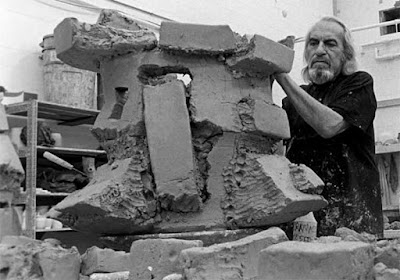In my art, I am searching for how to communicate my ideas on
the value of the Christian faith and worldview in relationship to the idea of
one’s personal security and how it is illustrated through the home and
family. I am seeking to illustrate
value, purpose, standards, and truth within these topics, but also the redemption
that is available when we fail. I believe there is
an ultimate security and standard to be found. What
does that look like? How can we attain it, then nurture and protect it?
Search This Blog
Wednesday, September 23, 2015
Thursday, September 17, 2015
History of American Ceramics - Where do I fit? Minimalism and Clay
Some studies and thoughts supporting graduate studio practice that will hopefully help me determine where I fall within the history of what we call American Ceramics....
Minimalism - an art movement of the 1950s - 1970s that stripped forms down to the essence of their being. Some refer to it as a reaction against the movement of Abstract Expressionism which brings to mind the work of Jackson Pollock or for us clay folk, Peter Voulkos. While there is no denying the brilliance of the abstract expressionist... I mean, look at the life that Voulkos brought to the clay... there is for me personally, some sort of comfort that can be seen in more minimal work.
When I think of minimalism, I think of Donald Judd and Carl Andre and I see order. There is repetition and order and for me, it is comforting. There are modular units that are grouped together to create a larger form or installation.
When we get to clay and this movement... Garth Clark has some interesting things to say about it. He says in his essay, "Geert Lap - Some Notes on Minimalism in Ceramic Art,"
"The modern traditions of ceramics have tended towards the expressionistic and the hand-made. Minimalism, with its implicit acceptance of the contemporary industrial landscape, has been suspect because of its identification with machine-made objects and materials. the more obvious the hand of the maker, most ceramicists believed, the more obvious the art content. The fear of being mistaken for machine-made production ware, in conjunction with a deeply felt anti-intellectualism and anti-conceptualism, has kept ceramics away from the minimalist arena."
Clark goes on to describe the art of Lap in the essay, but I would like to focus and think about what Clark said about clay people staying away from minimalism for fear of their work appearing machine made.
John Mason began to defy this in the 1970s with his large "X" forms and usage of firebrick to create modular units on the floor. The brick are yes, machine made....
But my interest is in the production of minimal forms in a way that still appears handmade. Currently, my solution to this is by press-molding... Not the most efficient way. There is something about the labor that is involved in creating the pieces each individually. I use my hand on each one and they have a story. Isn't this what is so powerful about clay? It has a memory. We have a memory. The metaphors that can be made between clay and the human life are infinite. Why is that?
I don't want to take away the hand and the story from the pieces, I create. They can be merged with the minimal form in which I personally press the clay. Why am I doing this? I don't have all the answers yet. That is why I am here and that is why I continue to make. If I knew the answer, I might just go try my hand in brain surgery.
Voulkos
Mason's Bricks
My Bricks
Subscribe to:
Comments (Atom)



